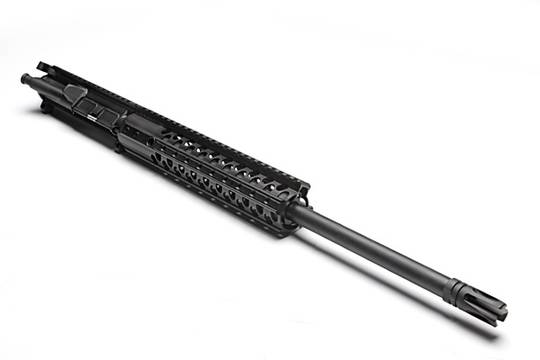[ This guest post was written by Brian Nelson. ]
Not quite a month ago, Wilson Combat released the new 7.62×40 WT (Wilson Tactical) round. When I first read about it, I wasn’t sure I had a use for it.
But after looking closer at it, I think it has a real future with 3-gun competitors wanting to make “major” power factor, and hunters that want a little more punch, without taking a big step up in size and weight. First this disclaimer: I haven’t actually shot this new round. However I have looked at it in person, and talked with the round’s designer, Kurt Buchert.
What is it?
Essentially, it’s a .223 case necked up to take a .30 caliber bullet. Wilson’s stated goal for the round was to “Develop an inherently accurate and low recoil cartridge in the immensely popular .30 caliber that has more terminal effectiveness than the 5.56 while utilizing as many standard AR platform 5.56/.223 components as possible.’’ The only caliber-specific component required is the barrel. Normal AR mags will accept the new round, but they won’t reach full capacity. Wilson also offers modified Lancer L5 mags (20 and 30 rounders) that will get full capacity.
“That sounds a lot like the .300 AAC Blackout!” Yes, they are both very similar rounds. They are made essentially the same way, however a suppressor company designed the .300 BLK for use with a suppressor (meaning it is designed as a subsonic round) and it’s shorter. The 7.62×40 can also easily be handloaded to subsonic velocities. And don’t go thinking that Wilson just stole AAC’s design and tweaked it a bit. Kurt Buchert, the round’s designer, had been playing around with it as a “Wildcat” (one-off custom round) as early as 2007.
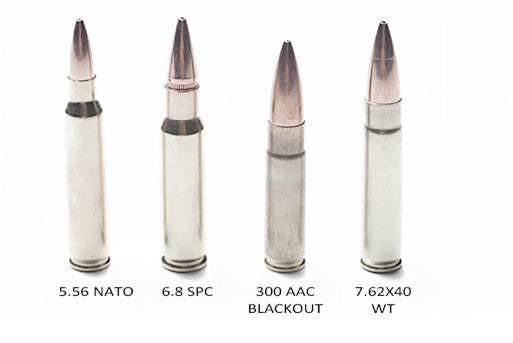
How?
.223 brass is trimmed down to an Overall length (OAL) of 1.560”, then run through a sizing die that stretches it out another five thousandths of an inch. It also widens the case neck to make room for more powder, and allows for the use of higher-pressure propellants such as Accurate 1680 or H110. The end result is a round that will work with the .223 bolt face and magazines, takes the common (and hard-hitting) .308 bullet, and (mostly) fits into .223 mags.

Application
Hopefully…on target :-). But seriously, the new round is very versatile. I really dig that it makes “Major” power factor in 3-Gun (more on that in a bit), and it’s also a substantial round for small- to mid-sized game such as deer and hogs. The round’s designer said that it was “Wildcat performance for hunters who don’t reload”. Wilson now makes ammo for the new round and it’s priced about the same as .223 match ammo.
3-Gun
For those of you not familiar with 3-Gun, it’s a high-adrenaline run-with-a-gun sport with -you guessed it- 3 Guns (rifle-pistol-shotgun). Different scenarios are set up with arrays of paper, steel, and clay targets that are engaged with different guns, all on the clock.
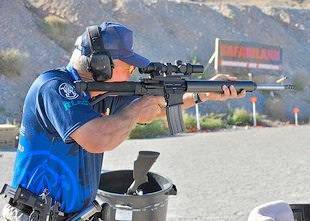

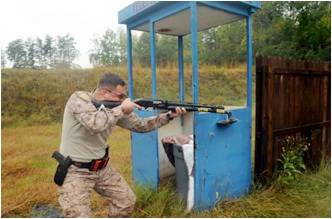
There are two methods of scoring, one of which is called the ‘’power factor’’. Different zones on the paper are given different scores if they are shot with “major” or “minor” power factor (or PF) rounds. Obviously those shot with “major” power factor rounds are scored higher than those shot with “minor” rounds. Power factor is calculated by multiplying the bullet weight by the velocity, then dividing by 1000. “Major” power factor is 320 or higher, “Minor” must be above 150. So if a .223 round is pushing a 55-grain bullet at 3100 fps, that’s 55×3100/1000, or 170.5 power factor (minor). Shooters must make at least “minor’’ to be allowed to compete.
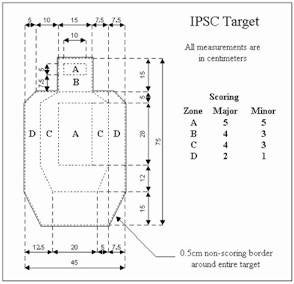
For years 3-Gunners got along just fine with the ‘’minor” PF .223 ammo, until the elite shooters of the Army Marksmanship Unit showed up at the 2009 Multi-Gun Nationals with custom AR’s built by the AMU’s own custom shop (which is truly a sight to behold). Chambered for a “Wildcat” round, the .30 Gremlin, they made Major PF, but ran on modified AR mags in normal AR receivers, with custom one-off bolts and barrels. But I’ve yet to see anyone except those with Uncle Sam building and paying for their guns and ammo using the .30 Gremlin as it’s a “wildcat”, with very few components, no reloading dies or any parts available for it.
Now consider the 7.62x40WT round. Wilson makes their ammo so that it will make major out of a 20’’ barrel, and it can be handloaded to make major out of a 16’’ barrel safely (but it will be veeeery hot). It’s based off of readily available .223 brass, easily trimmed and resized, and takes .308 bullets. It uses a .223 bolt, so it can be used with a “low-mass” carrier, which reduces recoil coming into your shoulder. In fact, the only unique component is the barrel, which is threaded to take AR-10 compensators/flash hiders, for obvious reasons (you ever try pushing a .30 cal bullet through a .22 cal hole?). Wilson offers modified Lancer L5 polymer mags, which there are magazine couplers and extensions for. Lancer mags will also work with the Arredondo Magwell; a popular accessory for 3 gunners. Unfortunately there is no way to make the new round work in a Beta C-mag (100 round drum).


Hunting
Say what you will about the AR platform for hunting, if you’re not opposed to using an AR then the 7.62×40 round is a fine round for it. As you can see, it’ll stop a hog or deer just fine, but it’s probably a little light for Elk. The new round hasn’t got a lot more kick to it than a .223, which makes it great for younger hunters.
Magazines
As I mentioned before, the only caliber-specific components required for the new round are the barrel and magazine. Normal .223 mags will take the 7.62×40, but they won’t work at full capacity. The ribs inside the magazine designed to keep the 5.56 round stacked uniformly will hit on the thick .30 caliber bullet and push them out of alignment.
Wilson offers modified Lancer L5 magazines, which are tough, transparent polymer. To modify the mags, they stick ‘em in a CNC machine and trim the ribs down. They then laser-engrave the floorplates. The magazines will still feed .223 flawlessly, though.
It’s also possible to modify polymer mags at home, using a hand file, but Wilson recommends using Lancer mags as they have functioned 100% with the new round. Unfortunately they found that Magpul Pmags aren’t as reliable as the Lancers are with the new round, so they won’t be offering any modified Pmags. It’s also impossible to modify metal USGI mags for the new round as the ribs are stamped into the metal. And, as I mentioned earlier, the new round won’t work in the Beta C-mag 100-round drum.
Handloading
If you can reload rifle ammo, it’s easy to reload the 7.62×40. But if you’re not set up to reload, Wilson does offer ammo at a decent price.
Handloading components and tools for the 7.62×40 are readily available as it’s based off of the .223 case and takes .308 bullets. Wilson offers pre-trimmed brass or you can trim your own on a case trimmer. It seem to me like the fastest setup would be a Dillon RT-1200 trimmer with a custom die (Dillon recommended CH4D), set up on a progressive press with a case feeder. Then trimming brass becomes no harder than pulling a lever.
As for dies, Wilson offers Hornady custom dies for 7.62×40, as well as case gauges. Load data can be found on Wilson’s website.
Build Your Own Gun
If you want to build your own AR for the new round, Wilson offers barrels complete with headspaced bolts. If you already have a bolt for .223 that you’d like to use, Pacific Tool and Gauge can make you headspace gauge for the new round. Pacific Tool also makes chamber reamers for it if you’d like to chamber your own barrel blank for the new round. They make the tooling that Wilson uses to make their guns in 7.62×40. As I’ve mentioned, the barrel is the only special part, so you can use your favorite handguard/bolt/carrier/whatever-the-heck-else-you-put-in-an-AR. Note however, that you have to use an AR-10 (.308) flash hider or comp on the 7.62×40.

Wilson also offers complete uppers chambered in 7.62×40, if you just want to bolt it on any Mil-Spec lower and be done with it. But where’s the fun in that? (Hint: shooting it!).
Conclusion
I for one think that it’s a very good round, and I agree with the Wilson guys that it’s the “Practical .30 cal AR solution”. I’ve been looking for a project for an unused AR lower for a while now, and I’ve settled on a 7.62×40 for both 3-gun and for hunting medium game (deer, boar, etc.). Thanks to Kurt Buchert for answering all my questions about the new round, and for giving me some of the gear to play around with.
 Your Privacy Choices
Your Privacy Choices



